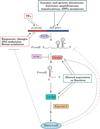Causes and consequences of microRNA dysregulation
- PMID: 22647357
- PMCID: PMC3528102
- DOI: 10.1097/PPO.0b013e318250c001
Causes and consequences of microRNA dysregulation
Erratum in
-
ERRATUM.Cancer J. 2020 Nov/Dec;26(6):561. doi: 10.1097/PPO.0000000000000481. Cancer J. 2020. PMID: 33298729 No abstract available.
Abstract
It is currently well recognized that microRNA deregulation is a hallmark of human cancer, and an aberrant expression of these tiny regulatory RNA molecules in several cell types is not just a random association, but it also plays a causal role in different steps of the tumorigenic process, from the initiation and development to progression toward the acquisition of a metastatic phenotype. Different regulatory mechanisms can control microRNA expression at a genetic or epigenetic level as well as involve the biogenesis machinery or the recruitment of specific transcription factors. The tumorigenic process implies a substantial alteration of these mechanisms, thus disrupting the equilibrium within the cell and leading to a global change in microRNA expression, with loss of oncosuppressor microRNAs and overexpression of oncomiRNAs. We review the main mechanisms regulating microRNAs and the consequences of their aberrant expression in cancer, with a glance at the possible implications at a clinical point of view.
Conflict of interest statement
Conflicts of Interest and Source of Funding: CM Croce is supported by grants of the National Cancer Institute; Iorio MV is supported by Start Up AIRC Grant.
References
-
- Lagos-Quintana M, Rauhut R, Lendeckel W, Tuschl T. Identification of novel genes coding for small expressed RNAs. Science. 2001;294:853–858. - PubMed
Publication types
MeSH terms
Substances
Grants and funding
LinkOut - more resources
Full Text Sources
Other Literature Sources


